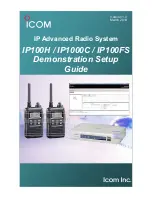
TX677 Instruction Manual
12 June 2018
© 2018 Standard Communications Pty Ltd trading as GME. All rights reserved.
2
50157
Preface
Preface
Copyright Notice
Standard Communications Pty Ltd reserves all rights to this document and the information contained
herein. Reproduction, use or disclosure to third parties without express permission is strictly
prohibited.
© 2018 Standard Communications Pty Ltd, Sydney, Australia
Safety Information
The TX677 is a radio transmitting device.
•
When transmitting, keep the antenna more than 25 mm from any part of the head or
body.
•
Do not transmit near electrical blasting equipment or in explosive atmospheres.
•
Do not allow children to operate a radio transmitter unsupervised.
Important Information Concerning UHF CB Radio
The use of the Citizen Band radio service is licensed in Australia by the ACMA Radio communications
(Citizens Band radio Stations) Class Licence and in New Zealand by the Ministry of Economic
Development New Zealand (MED). A General User Radio Licence for Citizens Band radio and
operation is subject to conditions contained in those licences. The class licence for users and
equipment operating in the CB/PRS 477 MHz band has been amended. This radio meets the new 80
channel standard.
In simple terms the same amount of spectrum is available; however, radio transceivers can now
operate in a narrower bandwidth and hence use less spectrum. These radios are generally referred
to as narrowband or 12.5 kHz radios. By using 12.5 kHz channel spacing instead of 25 kHz, the 40
channels originally allocated can now be expanded to 80 channels thereby doubling the channel
capacity and relieving congestion in the UHF CB/PRS band.
Original 40 channel wideband radios will continue to operate on the original 40 channels, however
they will not be able to converse on the newer channels 41 – 80. The newer narrowband radios will
be able to converse with all older 40 channel wideband radios on all channels 1 – 40 as well as the
newer channels allocated from 41 – 80. The mixing of narrowband and wideband radios in the same
spectrum can cause some possible operating issues of interference and varying levels of received
volume.
Possible Issues
When a new narrowband radio receives a transmission from an older wideband radio the speech
may sound loud and distorted – simply adjust your radio volume for best performance. When an
older wideband radio receives a signal from a new narrowband radio, the speech may sound quiet –
simply adjust your radio volume for best performance.



































